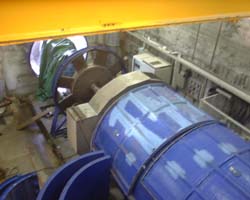A step closer to commercially exploitable wave energy plant
A consortium of European Universities and utilities companies has made an extensive feasibility study on the design, construction and commissioning of a pilot wave power plant of the oscillating water column type. The progress made and the possible commercial exploitation of such a power plant has boosted research even further and project partners have started designing and constructing the equipment necessary for the operation of the plant. It will be installed on the Island of Pico in the Azores, Portugal, on the northern shoreline of the island and will have an expected energy production of about 0.9 GWh per year. At the heart of this wave energy plant and one of the most important pieces of equipment used for its operation is obviously the electrical generator. Project partners have developed and own the exclusive rights of an asynchronous machine capable of operating over a relatively wide range of speeds. Such a machine will permit the air turbine to respond efficiently to a wide range of states in the energy source, i.e. the sea. In addition, the storage of kinetic energy to a flywheel will allow the turbine to produce a short term smoothing effect on the electric power that will eventually be delivered to the connected grid. The target being elimination of noticeable fluctuations in the power delivered to the customers. The asynchronous machine will perform as a generator if the state of the sea is such that it rotates the turbine at speeds higher than the synchronous speed and it will operate as a motor for speeds less than the synchronous. The technology of the generator is well established and relies on a simple, reliable and inexpensive machine. Moreover, the fact that converted power can be controlled over a wide range of speeds may also be applied to other similar applications, such as wind converters.

